
While there is hope that AI will help cybersecurity pros offset challenges such as keeping up with attackers, workforce shortages, and the ever-changing threat landscape, it is also important to keep an eye on what malicious actors are utilizing AI for.
In a recent paper, University of Illinois Urbana-Champaign researchers reported that OpenAI’s ChatGPT-4 was able to exploit vulnerabilities in real-world systems when given a Common Vulnerability and Enumerations (CVE) advisory describing the vulnerability. A CVE is the most widely used format for describing known vulnerabilities in databases such as the National Institute of Standards and Technology (NIST) National Vulnerability Database (NVD).
In this analysis, I’ll scrutinize the findings of the researchers’ report and explore the urgent need for organizations to fortify their defenses against these evolving risks.
Vulnerability Testing Insights
To conduct their study, the researchers used published vulnerability advisories that didn’t have a patch available yet. They were able to feed CVE descriptions to GPT-4 and leverage it to autonomously develop exploits of the vulnerabilities in quick fashion, with an 87% success rate. The researchers noted that not giving the large language model (LLM) agent access to the CVE descriptions reduced its success to just 7%, but the reality is that vulnerability descriptions are generally available in widely used vulnerability databases, which malicious actors have access to as well.
For the sample set, they chose a diverse set of vulnerabilities including those that were for websites, containers, and Python packages. The vulnerabilities tested included a sample case of 15 known vulnerabilities. Interestingly, the researchers found that 11 of the vulnerabilities in the testing sample were published after GPT-4’s release, meaning the model hadn’t even learned any data related to the vulnerabilities during its training and development, making the finding even more impressive and concerning.
Ask Cloud Wars AI Agent about this analysis
To emphasize the economic utility of AI versus traditional human testers, the researchers also pointed out that the cost to conduct the exploit for the LLM agent was about $8.08 per exploit — much more affordable than human capital. This demonstrates not just speed and technology but also economic efficiencies which will further drive cybercrime organizations to lean into automating their activities and using technologies such as AI.
While skeptics and professionals have pointed out that the vulnerabilities exploited were relatively simple, it is still indicative of the future potential of GenAI and LLM tools to accelerate the exploitation of vulnerabilities by malicious actors.
It is even more concerning for other reasons. The CVE count in databases such as NVD has grown exponentially year-over-year, surging past 200,000 known vulnerabilities and over 20,000 vulnerabilities published in 2023. This comes at a time when organizations are struggling terribly to keep pace with the growing rate and number of vulnerabilities, with backlogs in the several hundred thousand to even millions in large, complex environments.
It isn’t just new vulnerabilities without patches that malicious actors are targeting either, as “vintage vulnerabilities” remain a key target for attackers. These are known vulnerabilities with available patches in most cases that simply haven’t been resolved, as organizations struggle to keep pace with the growing vulnerability backlogs and determine what vulnerabilities should be prioritized and patched immediately and which ones can afford to be put into a backlog.
This is why we’re seeing the rise of vulnerability intelligence resources such as the Known Exploited Vulnerability (KEV) catalog from the Cybersecurity and Infrastructure Security Agency (CISA) and the Exploit Prediction Scoring System (EPSS). These resources seek to help organizations prioritize vulnerabilities that are either known to actively be exploited or may be exploited soon.
All this being said, attackers continue to capitalize on the chaos. In fact, Mandiant’s 2024 M-Trends report found that exploits of vulnerabilities were on the rise, accounting for 38% of compromises they identified. This was an increase from 32% the year prior and there was also a decrease in other attack types such as phishing.
Final Thoughts
As the attack surface continues to grow, and organizations struggle to keep pace with vulnerabilities and reduce risk, attackers are exploring and building proficiencies in emerging technologies such as AI to accelerate their rate of exploitation and impact. This underscores the importance of defenders and organizations doing the same, building competencies in AI and leveraging the same technologies to outpace malicious actors and drive down vulnerabilities and risks.

The AI Ecosystem Q1 2024 Report compiles the innovations, funding, and products highlighted in AI Ecosystem Reports from the first quarter of 2024. Download now for perspectives on the companies, investments, innovations, and solutions shaping the future of AI.










